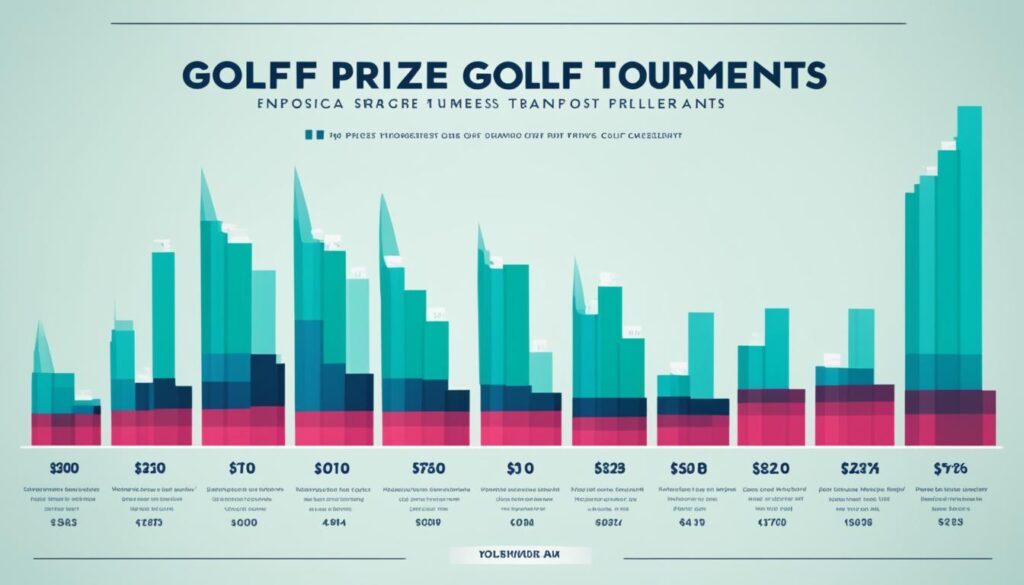Golf tournament formats have undergone significant changes throughout history, shaping the way the game is played and enjoyed today. From the early days of separate tournaments organized by individual clubs or sponsors to the establishment of formal tours, the structure of golf competitions has evolved to meet the ever-changing needs and interests of players and fans alike.
In this article, we’ll explore the historical development of golf tournament formats and delve into the popular trends that have emerged in the world of golf competitions. By understanding the evolution of tournament structures, we can gain a deeper appreciation for the game and its continuous growth.
Key Takeaways
- The structure of golf tournaments has evolved significantly over time.
- Early tournaments were separate events organized by individual clubs or sponsors.
- The establishment of professional tours brought greater organization and continuity to golf competitions.
- Major tours like the PGA Tour, European Tour, and LPGA Tour have a busy tournament schedule throughout the year.
- Modern golf tournaments incorporate innovative setups and formats to enhance the spectator experience.
The Beginnings of Golf Tournaments
In the early days of professional golf, each region or club would organize separate tournaments, leading to a lack of continuity and structure in the competition format. As the popularity of golf grew and the number of tournaments increased, the need for a more organized tour system became apparent. Thus, the concept of a tour, supervised by a single organization, started to take shape. This shift towards a more formalized structure laid the foundation for the modern golf tournament formats we see today.
“The growth of the golf industry demanded a more organized approach to competitive play,” says Bob Smith, a golf historian. “The early days were characterized by individual clubs or regions hosting their own tournaments, with no cohesive structure. This made it challenging for players and fans to keep track of the competition.”
Recognizing the need for change, golf organizations began establishing governing bodies to oversee the tour system. These bodies implemented consistent rules, standardized formats, and ensured that tournaments were scheduled in a way that would attract both players and spectators. The introduction of a tour system brought about a new era in golf, where professional players could participate in a series of events, earn rankings, and capture the attention of fans around the world.
Gradually, the golf community embraced this shift towards a more organized and structured approach to tournaments. It provided players with enhanced opportunities to showcase their skills, compete against top talent, and pursue a career as professional golfers. The evolution of golf tournament formats continued over the years, leading to the diverse and exciting array of competition styles we witness today.
As the sport became more global, international golf organizations emerged, further shaping the landscape of professional golf tournaments. These organizations worked collaboratively to establish prestigious events, such as major championships and invitational tournaments, attracting the world’s best players. The amalgamation of regional tournaments into international tours opened doors for golfers worldwide, fostering a spirit of competition and camaraderie.
One notable example of this evolution is the transformation of the U.S. Open, initially a national championship, into a major international event. The U.S. Open’s inclusive format now welcomes elite golfers from around the world, showcasing the sport’s global reach and embracing diversity. This trend towards openness and inclusivity has become a standard practice in modern golf tournaments, creating an exciting and dynamic playing field.
“The shift towards more standardized tour structures and inclusive formats has been instrumental in promoting the growth of golf,” says Sarah Johnson, a golf industry analyst. “Today, we have a rich tapestry of tournament formats that cater to diverse playing preferences and engage fans across the globe.”
Golf tournament formats have evolved significantly, providing endless entertainment for players and spectators alike. From the early days of disparate tournaments to the establishment of professional tours and the development of international cooperation, the changes in golf event formats have enhanced the sport’s allure and global appeal. As we delve further into the history and evolution of golf tournaments, we’ll explore the birth of professional golf tours and the financial aspects that underpin the success of these prestigious events.
The Birth of Professional Golf Tours
One of the most significant developments in golf tournament formats was the establishment of professional tours. The PGA Tour, founded in the United States, is often credited as the pioneer of the tour system. It officially became a distinct entity from the PGA of America in 1968. Other major tours, such as the European Tour and the LPGA Tour, followed suit, providing a platform for professional golfers to compete in a series of events, earn prize money, and showcase their skills on a global stage.
These professional golf tours revolutionized the sport by creating structured seasons, rankings, and standardized rules across multiple events. They offered opportunities for players to compete against the best in the world, attracting top talent and fostering a highly competitive environment.
The PGA Tour, with its rich history and deep pockets, quickly became the premier professional golf tour. It attracts golfers from all over the world, hosting prestigious tournaments like The Masters, U.S. Open, and The Players Championship. The PGA Tour’s success inspired the creation of other professional tours in different regions, including the European Tour and the LPGA Tour.
The European Tour, established in 1972, caters to the best golfers from Europe and has grown to include events in multiple countries. It features prominent tournaments such as the BMW PGA Championship and the Open Championship.
The LPGA Tour, founded in 1950, is the premier women’s professional golf tour. It offers a platform for female golfers to showcase their skills and compete in prestigious tournaments like the ANA Inspiration and the U.S. Women’s Open.
“The birth of professional golf tours paved the way for golfers to make a career out of the sport. It created a structured pathway, increased prize money, and brought greater exposure to the game.” – Golf Enthusiast
Benefits of Professional Golf Tours:
- Opportunity for golfers to compete against the best in the world
- Increase in prize money and financial rewards
- Standardized rules and rankings
- Exposure and global recognition for players

Structure of Tour Golf
Today, there are more than twenty professional golf tours worldwide, each run by a Professional Golfers Association (PGA) or an independent tour organization. These tours arrange events, find sponsors, and regulate the tour. Major tours like the PGA Tour, European Tour, and LPGA Tour have a busy tournament schedule throughout the year. Golfers can earn their tour cards to become members of these leading tours by succeeding in entry tournaments or achieving a designated level of success in other competitions. Lesser tours are open to any registered professional who pays an entry fee.
| Tour | Tournament Schedule | Membership Requirements |
|---|---|---|
| PGA Tour | Regular season events from January to September, followed by the FedExCup Playoffs | Earn a tour card through the Korn Ferry Tour Finals or through performances in select events |
| European Tour | Events throughout Europe, Asia, and the Middle East, including the Rolex Series | Automatic membership for top-ranked players, others through performances in Q-School or Challenge Tour |
| LPGA Tour | Events primarily in the United States, with a few international tournaments | Earn a tour card through the LPGA Qualifying Tournament or through high finishes as a non-member |
These major tours provide a stable platform for professional golfers to compete at the highest level and earn substantial prize money, while also offering exposure to worldwide audiences through television coverage and sponsorship opportunities.
Financial Aspects of Professional Golf Tours
The financial rewards offered by professional golf tours can vary significantly, with prize money being a major driving force for players. The top-tier tours, such as the PGA Tour in the United States, stand out with their substantial financial rewards compared to lower-tier tours. For instance, the PGA Tour offers nearly a hundred times more prize money each season than the third-tier NGA Pro Golf Tour.
Let’s take a closer look at the financial aspects that contribute to the success of top-tier tours and the fluctuations experienced by lower-tier tours:
Prize Money
Prize money is an integral part of professional golf tournaments and serves as a financial incentive for players to compete at the highest level. Top-tier tours, like the PGA Tour, offer lucrative prize purses, attracting the world’s best players to compete in prestigious events. The prize money on these tours can range from thousands to millions of dollars per tournament, with the most prestigious tournaments offering the largest payouts. Lesser-known tours may have comparatively lower prize money, but they still provide opportunities for aspiring golfers to earn a living and gain valuable experience.
Sponsorship Deals
Another crucial aspect affecting the financial success of golf tours is sponsorship deals. Sponsors play a significant role in funding tournaments by providing financial support, which contributes to the overall prize money. Top-tier tours often secure high-profile sponsors, leading to increased prize funds and higher financial rewards for players. These sponsorships can come from various sources, including corporations, brands, and even individual philanthropists who are passionate about the sport.
Health of the Golf Industry
The financial stability of professional golf tours is also influenced by the overall health of the golf industry. An industry experiencing growth and increased popularity tends to attract more sponsors, which, in turn, leads to higher prize money. However, economic downturns or periods of low interest in golf can create challenges for tours, potentially impacting the amount of prize money available.
Tour Comparisons
To provide a clearer picture of the financial disparities among tours, let’s compare the prize money offered by the PGA Tour, European Tour, LPGA Tour, and NGA Pro Golf Tour.
| Tour | Prize Money (Approximate) |
|---|---|
| PGA Tour (Top-tier) | $400 million per season |
| European Tour (Top-tier) | $191 million per season |
| LPGA Tour (Top-tier) | $75 million per season |
| NGA Pro Golf Tour (Third-tier) | $4 million per season |
The above figures are approximate and subject to change based on factors such as sponsorships and the overall growth of the industry. However, they highlight the significant differences in prize money between top-tier and lower-tier tours.
“The financial success of professional golf tours is crucial for providing golfers with the financial rewards they deserve for their skill and dedication.” – Professional Golfer
Various initiatives have been implemented to enhance the financial rewards for golfers on lower-tier tours and create a more sustainable ecosystem. Some tours have introduced strategic initiatives to increase prize money, attract sponsors, and support the growth and development of golf at all levels.

The financial rewards offered by professional golf tours play a pivotal role in the livelihood of golfers and the overall health of the sport. As golf continues to evolve, it is important to ensure that financial stability and competitive opportunities are available across all tiers of professional golf, empowering players to pursue their dreams and contribute to the growth of the game.
International Federation of PGA Tours
The International Federation of PGA Tours, established in 1996, serves as an essential organization for leading tours in the world of professional golf. The Federation brings together renowned tours, including the PGA Tour, PGA European Tour, Japan Golf Tour, PGA Tour of Australasia, and Sunshine Tour, to address common issues and promote collaboration within the golfing community.
Since its inception, the Federation has expanded its membership to include other prominent tours and associations worldwide, fostering a global network of golfing excellence. By joining forces, these tours aim to enhance the sport and ensure its continued growth and success.
The International Federation of PGA Tours fosters collaboration and global excellence in professional golf.
Tournament Formats and Innovations
Alongside the development of professional tours, golf tournament formats have continued to evolve. Tournaments now incorporate various creative setups and adaptations to enhance the spectator experience.
One innovative golf tournament setup that has gained popularity is stadium golf. In stadium golf, courses are designed with optimal viewing opportunities in mind, allowing fans to get up close to the action and enjoy a more immersive experience. With strategically placed grandstands, elevated vantage points, and spectator-friendly layouts, stadium golf brings golf fans closer to their favorite players and creates an electric atmosphere.
In addition to stadium golf, there has been a rise in team-based events that showcase a different dimension of competition. The Ryder Cup, for instance, pits teams from Europe and the United States against each other in a highly anticipated match play format. The Presidents Cup follows a similar concept with teams representing the United States and the rest of the world (excluding Europe). These team-based events not only showcase the skills of individual players but also foster camaraderie and team spirit, adding an exciting dynamic to the sport.
Furthermore, new tournament formats such as match play and alternate shot have added further excitement and unpredictability to professional golf. Match play tournaments involve head-to-head matchups, where golfers compete hole by hole rather than the traditional stroke play format. This format often results in dramatic moments and upsets, making for compelling viewing and intense competition.
| Tournament Format | Description |
|---|---|
| Stadium Golf | A setup that maximizes spectator experience with strategically placed grandstands, elevated vantage points, and spectator-friendly layouts. |
| Team-based Events | Events like the Ryder Cup and Presidents Cup that feature teams competing against each other, fostering camaraderie and team spirit. |
| Match Play | A format where golfers compete hole by hole rather than stroke play, resulting in dramatic moments and intense competition. |
| Alternate Shot | A format where two players take turns hitting a single ball, adding a strategic element and requiring teamwork. |
These innovative tournament setups and modern golf tournament styles have reinvigorated the sport, attracting new audiences and keeping fans engaged. As golf continues to evolve, we can expect further creative adaptations and formats that push the boundaries of the game.
Conclusion
The evolution of golf tournament formats has played a significant role in shaping the game and its global appeal. Throughout history, golf formats have transitioned from scattered individual tournaments to the establishment of professional tours, bringing structure and continuity to the sport.
Financial aspects have also influenced the changing landscape of golf competitions. The top-tier tours, such as the PGA Tour, offer substantial prize money, attracting the best players and generating widespread interest. This, in turn, strengthens the overall competitiveness and popularity of the sport.
International collaboration among various tours through organizations like the International Federation of PGA Tours has further propelled the evolution of golf. This collaboration has led to the creation of prestigious events like the World Golf Championships and the development of the Official World Golf Ranking, elevating the status and global reach of the game.
Innovations in tournament setups and formats have brought excitement and entertainment to both players and fans. From stadium golf to team-based events like the Ryder Cup, golf competitions have evolved to provide thrilling experiences for spectators. The ever-evolving tournament formats continue to shape the future of golf and offer new possibilities for players and fans alike.
FAQ
How have golf tournament formats evolved over time?
Golf tournament formats have evolved significantly, from individual club tournaments to the establishment of professional tours and the incorporation of innovative setups and adaptations.
What were the early golf tournament formats like?
In the early days, golf tournaments were organized separately by individual clubs or sponsors, leading to a lack of structure and continuity.
When were professional golf tours established?
The concept of professional golf tours started to take shape in the late 1960s, with the establishment of the PGA Tour in the United States. Other major tours like the European Tour and LPGA Tour followed suit.
How do professional golf tours work?
Professional golf tours arrange a series of events throughout the year, where players compete for prize money and tour cards. Golfers can become members of the leading tours by succeeding in entry tournaments or achieving a certain level of success in other competitions.
What is the financial aspect of professional golf tours?
The financial rewards offered by professional golf tours vary, with top-tier tours like the PGA Tour offering significantly higher prize money compared to lower-tier tours.
What is the International Federation of PGA Tours?
The International Federation of PGA Tours is an organization formed by leading professional golf tours to discuss common issues in the sport. They also sanction the creation of World Golf Championships and play a role in the Official World Golf Ranking.
What are some innovative tournament formats in golf?
Golf tournaments now incorporate creative setups such as stadium golf, team-based events like the Ryder Cup and Presidents Cup, as well as formats like match play and alternate shot.
How has the evolution of golf tournament formats impacted the game?
The evolution of golf tournament formats has shaped the game and its global appeal by providing more structure, organization, and entertainment for players and fans alike.



